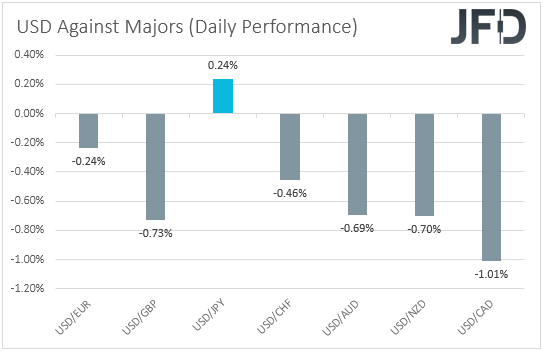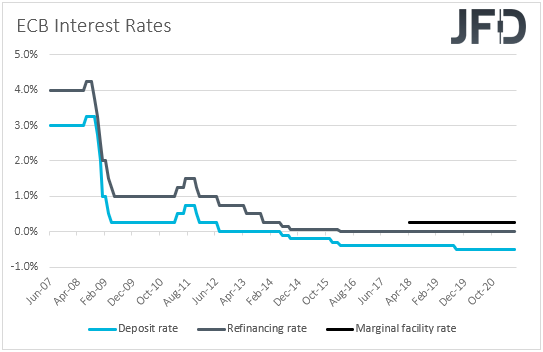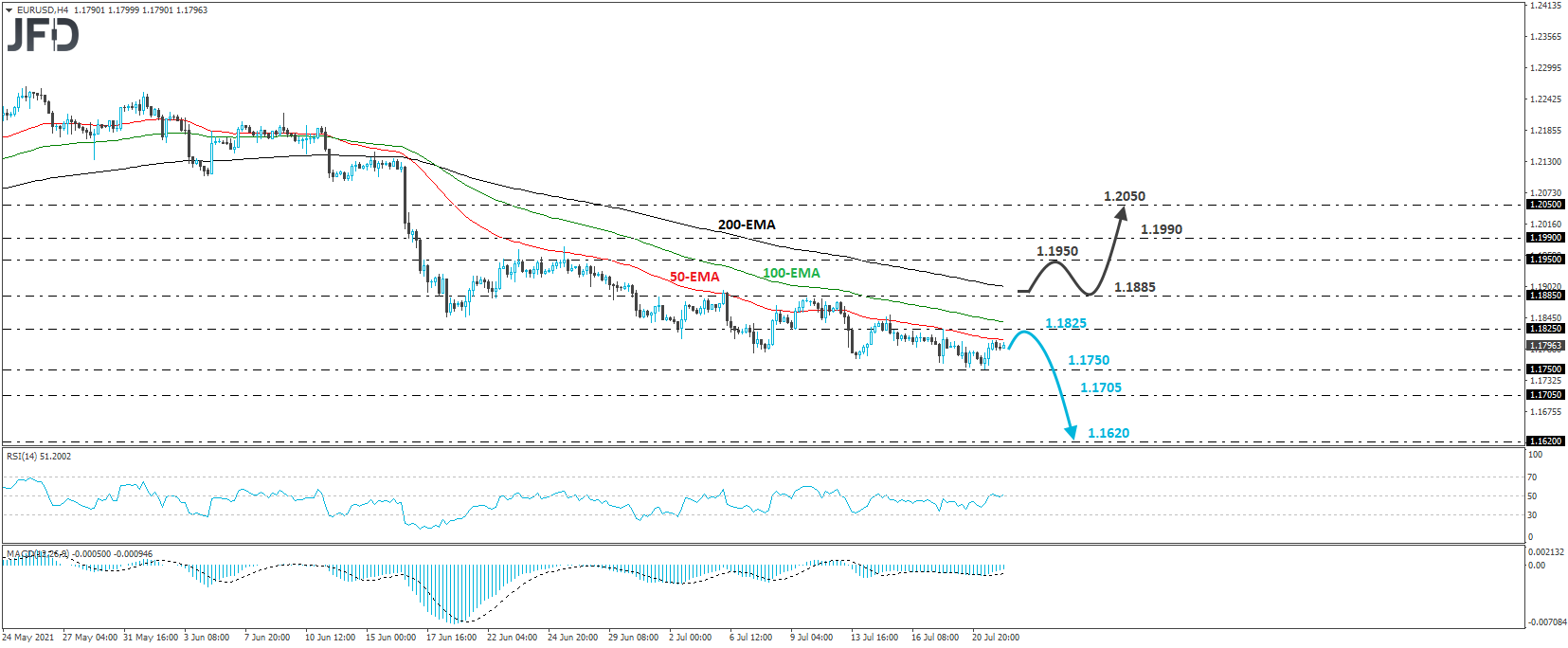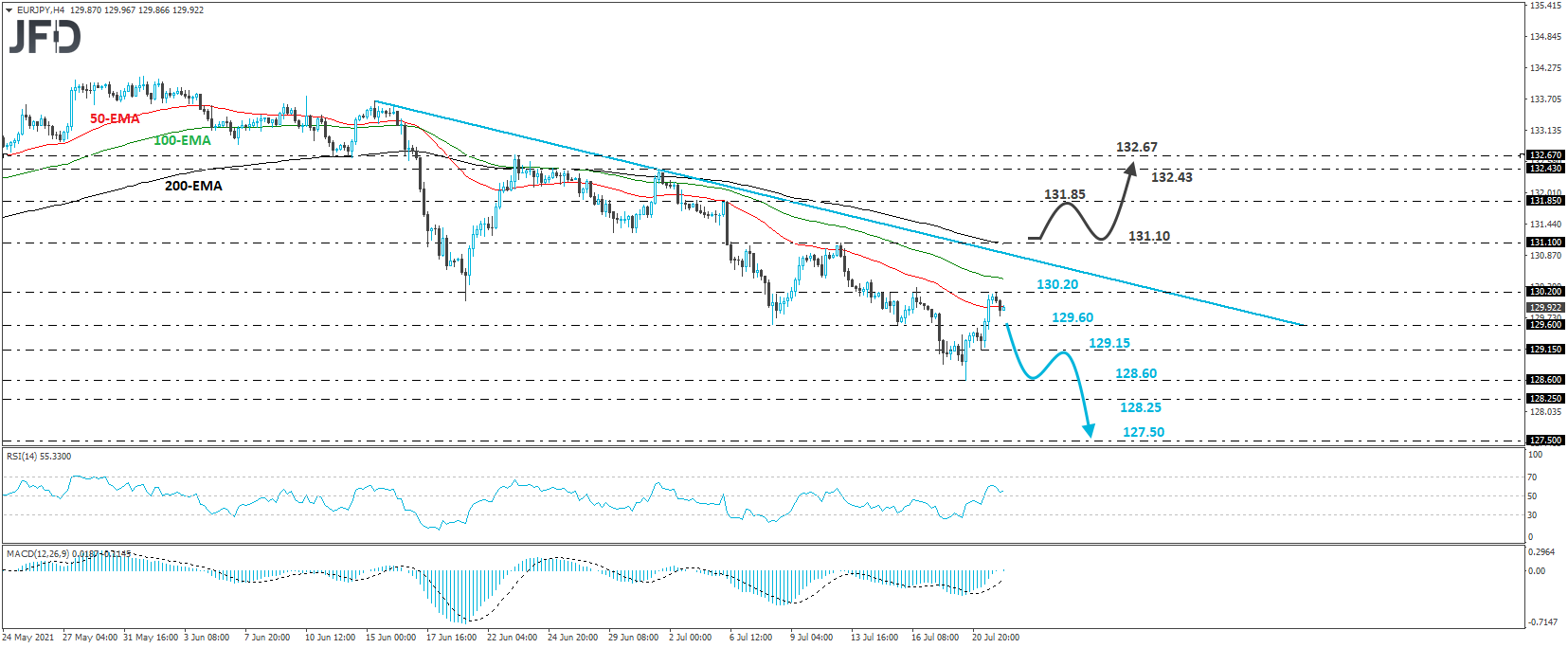The US dollar slid, while equities gained on Wednesday and during the Asian session Thursday, perhaps due to further easing of concerns over the fast-spreading coronavirus.
As for today, all the attention may fall on the ECB decision. Considering the subdued core inflation rate, the dovish remarks by several policymakers, and the change in their inflation objective, we believe that the Bank will highlight once again the need for extra-loose policy for longer.
Equities Gain On Easing Virus Concerns; ECB Center State
The US dollar turned south and underperformed against all but one of the other major currencies on Wednesday and during the Asian session Thursday. It gained only against JPY, while it underperformed the most versus CAD, GBP, and NZD in that order.
The weakening of the US dollar and the strengthening of the commodity-linked loonie and kiwi suggest that investors’ risk-appetite continued to improve yesterday and today in Asia. Indeed, shifting attention to the equity world, we see that major EU and US indices were a sea of green, with the optimism rolling into the Asian session today. Japan’s Nikkei remained closed due to a holiday.
It seems that concerns over the fast-spreading Delta variant of the coronavirus continued to ease, perhaps due to upbeat earnings results, or because, as we said yesterday, market participants may have had second thoughts over how restrictive any potential new measures could be.
In our view, following the economic damages caused from the previous lockdowns, the world may not be able to handle another round of such kind of restrictions. So, any new measures could be softer, as vaccination rates limit the severity of symptoms of new cases. Thus, with that in mind, we stick to our guns that, even if we experience another round of selling in equities in the foreseeable future, we will not call for a reversal. We still believe that the broader path remains positive and that any setbacks may trigger more buying, perhaps on fear of missing out.
As for today, all lights will fall on the ECB monetary policy decision. At their latest meeting, policymakers of this central bank kept all their policy settings unchanged, noting that the PEPP (Pandemic Emergency Purchase Program) will continue to run at a “significant higher pace.”
The Bank raised its 2021 and 2022 GDP and inflation forecasts, but at the press conference following the decision, ECB President Lagarde clarified that headline inflation will remain below target over the forecast horizon. She admitted that they were somewhat more optimistic about the economic outlook than three months ago, but highlighted that the decision statement was unanimously supported, suggesting that tapering was not on any official’s mind at the moment.
Since then, both the headline and core CPI rates ticked down to +1.9% yoy and 0.9% yoy, from +2.0% and +1.0% respectively. Despite the headline rate staying near 2%, the core one is still decently below that mark, adding credence to the view of policymakers like ECB President Lagarde, Chief Economist Philip Lane, and Executive Board member Fabio Panetta, who agree that monetary and fiscal policy support should not be withdrawn prematurely.
The only one whose comments were somewhat more hawkish was Governing Council member Jens Weidman, who said that “inflation is not dead” and that he wants to discuss when emergency ends from a monetary policy point of view. What’s more, a couple of weeks ago, the Bank set a new 2% inflation objective, saying that it could tolerate temporary moves beyond that mark. Remember that the prior target was to achieve inflation “below, but close to, 2%.”
In our view, all this suggests that the Bank is likely to keep interest rates at historic lows for longer and perhaps continue with its asset purchase-programs for longer as well. That said, with Weidman arguing that it will not be right for the PEPP to continue running after the pandemic is over, his colleagues may just decide to replace it with another form of QE when it comes to an end.
Such a dovish stance is likely to weigh on the euro, which could suffer the most against currencies, the central banks of which are already discussing the timing of when they may start raising interest rates, like the US dollar and the New Zealand dollar.
EUR/USD – Technical Outlook
EUR/USD traded slightly higher on Wednesday, after hitting support at 1.1750. However, the price structure remains of lower highs and lower lows, which means that the short-term trend is still to the downside, although the rate of decrease may have slowed recently. Thus, in the absence of trend reversal signals, we will still see a negative near-term picture.
A dovish ECB could confirm the outlook, perhaps pushing the pair back down for another test at 1.1750, where a break would confirm a forthcoming lower low and may initially target the 1.1705 barrier, marked as a support by the low of Mar. 31. If the bears are willing to push the rate even lower, then the next territory to consider as a support could be at 1.1620, which stopped the pair from drifting further south on Nov. 2 and 4.
On the upside, a break above 1.1885 is the move that could force us to abandon the bearish case. That barrier has been acting as a strong resistance since the beginning of the month and thus, its break may signal a material change in sentiment towards this exchange rate. The bulls may then target the 1.1950 hurdle, or the 1.1990 barrier, the break of which could extend the advance towards the 1.2050 area, defined as a resistance by the low of May 13.
EUR/JPY – Technical Outlook
EUR/JPY edged north as well yesterday, but the recovery remained limited near 130.20, still well below the downside resistance line drawn from the high of June 15. As long as the rate stays below that line, we will consider the short-term outlook to be negative and we would see decent chances for the bears to take charge again soon.
A slide below 129.60 may signal that the current upside corrective phase is over and may initially target yesterday’s low of 129.15, the break of which could pave the way towards Tuesday’s low of 128.60.
If the bears do not stop there, a break lower would confirm a forthcoming lower low and aim for the 128.25 barrier, marked by the low of May 24, the break of which could carry larger bearish implications, perhaps setting the stage for declines towards the low of Feb. 22, at 127.50.
Now, in order to start examining whether the bulls have gained full control, we would like to see a move above 131.10, which provided resistance on July 13. This will also take the rate above the aforementioned downside resistance line and may encourage the bulls to shoot for the peak of July 6, at 131.85.
Another break, above 131.85, could carry extensions towards the 132.43 barrier, marked by the high of July 1, or the peak of June 23, at 132.67.
As For The Rest Of Today's Events
Besides the ECB decision, on today’s agenda, we also have the US existing home sales for June and the initial jobless claims for last week. Existing home sales are forecast to have increased somewhat, while jobless claims are expected to have slightly declined.
